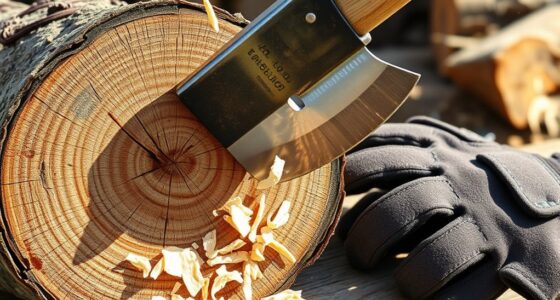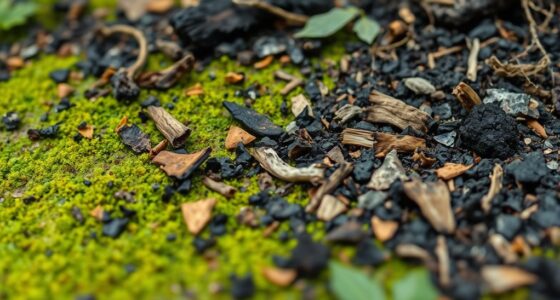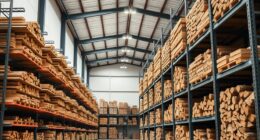When choosing firewood for cooking or heating, consider your primary goal. For cooking, you want hardwoods like apple or cherry that burn cleanly and produce less smoke, ensuring good flavor and safety. For heating, hardwoods like oak or hickory provide steady, long-lasting warmth. Softwoods ignite faster but burn quickly, making them better for short-term heating. Properly seasoned, dry firewood is essential for both, helping you burn efficiently and protect the environment. Keep exploring to learn how to select and prepare the best firewood for your needs.
Key Takeaways
- Cooking firewood should burn cleanly with minimal smoke, while heating firewood prioritizes long-lasting, steady warmth.
- Hardwoods like oak and hickory are suitable for both purposes, but softwoods are better for quick heating.
- Properly seasoned, dry firewood reduces smoke, emissions, and creosote buildup, benefiting both cooking and heating.
- Fruitwoods like cherry and apple are ideal for cooking due to cleaner burns and aromatic qualities.
- Sustainable sourcing and dry storage enhance efficiency and minimize environmental impact for both uses.

When choosing firewood, it’s important to contemplate whether you’ll mainly use it for cooking or heating, as each purpose requires different qualities. For cooking, you’ll want wood that burns cleanly, produces minimal smoke, and offers consistent heat. Hardwoods like oak, hickory, or fruitwoods such as apple and cherry are ideal because they burn longer and provide a steady, hot fire suitable for grilling or smoking. These woods tend to produce less creosote and smoke, which is better for indoor air quality and reduces environmental impact. If you’re considering wood burning for cooking, you should prioritize sustainably sourced hardwoods that burn efficiently, minimizing the environmental footprint of your cooking practices. Additionally, choosing sustainable harvesting methods ensures that your firewood consumption contributes to forest conservation and ecological balance.
On the other hand, if your primary goal is heating, you’ll need firewood that provides sustained, steady warmth over longer periods. Softwoods like pine or cedar ignite quickly and produce a lot of heat initially, but they tend to burn faster and produce more creosote, which is detrimental to your chimney and the environment if not managed properly. For heating, hardwoods are preferred because they generate more heat per volume and burn more slowly, making them more economical and environmentally friendly in the long run. When selecting firewood for heating, consider the environmental impact of your choice. Properly seasoned, sustainably harvested wood reduces emissions and contributes less to air pollution. Burning dry, seasoned hardwoods results in cleaner combustion, lowering your carbon footprint and preserving air quality. Using properly seasoned firewood not only enhances efficiency but also reduces the environmental impact by minimizing smoke and emissions.
It’s also essential to think about the moisture content of your firewood. Wet or green wood, regardless of type, burns inefficiently, producing more smoke and pollutants. This not only impacts the environment but can also lead to creosote buildup in chimneys, increasing fire hazards. Properly drying your firewood ensures a cleaner burn, whether for cooking or heating, and minimizes harmful emissions. The environmental impact of burning wood depends heavily on how the wood is harvested, processed, and stored. Using locally sourced, sustainably harvested firewood reduces transportation emissions and supports responsible forest management. Additionally, paying attention in creative practice can help you develop better techniques for selecting and preparing your firewood to maximize efficiency and sustainability.
Frequently Asked Questions
What Type of Firewood Is Safest for Indoor Cooking?
For indoor cooking, hardwoods like oak, maple, or cherry are safest because they produce less smoke and creosote buildup, ensuring better wood safety. These woods burn cleaner, reducing indoor air pollution. Always use well-seasoned, dry firewood to minimize smoke and harmful emissions. Avoid softwoods like pine or cedar, which emit more sap and resin, increasing the risk of dangerous fumes. Proper ventilation also enhances safety during indoor cooking with firewood.
How Does Firewood Moisture Content Affect Heating Efficiency?
When firewood has high moisture levels, it burns less efficiently, reducing combustion efficiency and producing more smoke and creosote. You’ll find that properly seasoned firewood with low moisture content burns hotter and cleaner, maximizing heat output. To improve heating efficiency, guarantee your firewood’s moisture levels are below 20%, which allows for more complete combustion and better heat transfer, making your heating experience safer and more effective.
Are There Environmental Concerns With Using Firewood for Cooking?
Using firewood for cooking can sometimes cause serious environmental concerns, like contributing to air pollution and deforestation. You might not realize it, but burning wood releases harmful particles that worsen air quality, affecting your health and the environment. Overharvesting wood accelerates deforestation, destroying habitats and reducing essential oxygen production. So, it’s important to source firewood responsibly and consider eco-friendly alternatives to protect our planet’s future.
What Are the Best Firewood Storage Tips to Prevent Pests?
To prevent pests, you should follow these firewood storage tips. Store your firewood off the ground on a pallet or rack to improve airflow and reduce moisture. Keep it in a dry, well-ventilated area away from your home to prevent pest infestation. Cover the top with a tarp, but leave the sides open for air circulation. Regularly inspect and rotate your firewood to catch pests early.
How Do Firewood Types Impact Indoor Air Quality During Heating?
Think of your firewood like a band—different types bring unique sounds, or in this case, impacts on indoor air quality. Hardwoods like oak burn cleaner, producing less indoor pollution, while softwoods like pine release more creosote and airborne particles. Using the right firewood reduces indoor pollution and keeps your home’s air quality clear as a bell. Choose wisely to breathe easy and enjoy a warm, healthy environment.
Conclusion
Whether you choose firewood for cooking or heating, remember it’s about balance, efficiency, and safety. Firewood fuels your meals and warms your home, offering comfort and tradition. It requires preparation, care, and respect for the wood and your surroundings. By understanding your needs, you can make informed choices, ensuring each fire lights up your day and night. Firewood connects you to nature, to history, and to simple pleasures—so embrace it, and let it serve you well.











